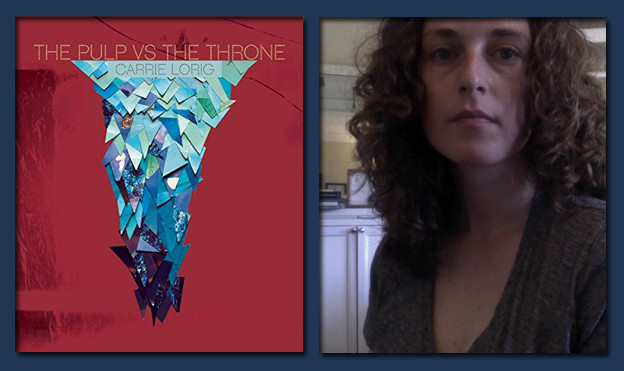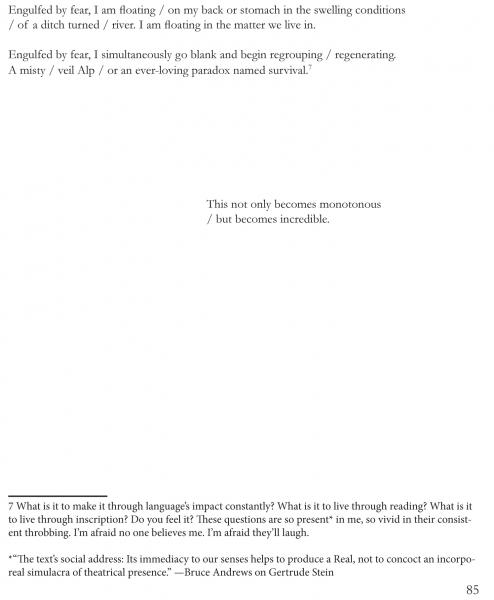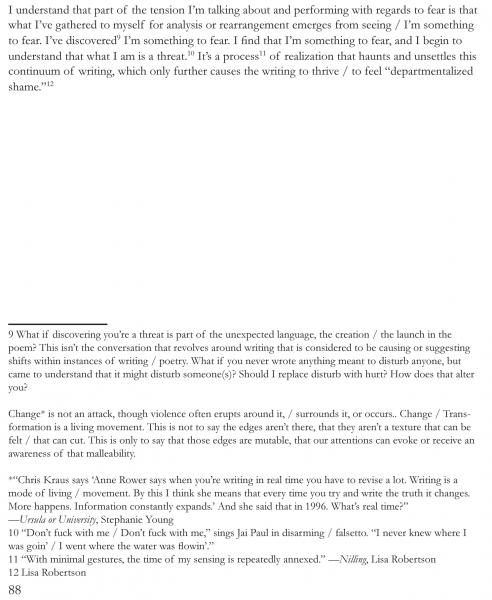Unregulated glamor
On Carrie Lorig's 'The Pulp vs. the Throne'

The Pulp vs. the Throne
The Pulp vs. the Throne
Last week I was walking through the UC Berkeley campus with a friend who is a birth/care worker. We were on our way to hear Bernadette Mayer read — “our grand-auntie,” we said. We were talking about aspirations, the work my friend aspires to most, and my friend was speaking about helping women decide when and how they want to give birth. She was telling me about all sorts of care methods that I, at thirty years old, knew nothing about.
As we approached a public space with a large concentration of people, my friend stopped, lowered her voice, and whispered, “probably shouldn’t talk about this here.” My friend was speaking of doing work that she loves on her own body and the bodies of others she loves, but was too afraid to continue there among unknown others. The conversation ended as English Department building doors swung shut behind us, just as so many conversations end upon entering public spaces that don’t welcome them. I’ve been Googling since then, searching for the words my friend was saying, suddenly fearful about the closing shut behind my friend.
Carrie Lorig’s first collection, The Pulp vs. the Throne, is an antidote to these kinds of closures, a gasping and shouting collection that insists on talking about everything, and talking about it here. It’s not easy: it’s not usually an easy task to read a book that refuses finishing, a book that refuses closure entirely. Lorig’s is a wide-reaching grasp of a book that attempts this ultimate lack of closure, ultimate engagement and availability.
Lorig’s book takes the form of a set of linked long poems, all of which cite other writers and extensive correspondence (emails, texts, more) to form a massing sense of research and a mind speaking with what has come before it. The poems in The Pulp vs. the Throne are both rigorously careful in their relationship with sources (footnoted, closely explained), and careless in their roll through them, a movement from source to source, an associative roll that evokes a mind amongst peers in thought, a mind reaching for a rigor that makes authentic sense to its individuality.
It is difficult to cite Lorig well outside of her own form (which is a fact, in itself, something authentic to the work) without erasing parts of how it is presented. An image[1] works best:

As above, we read with Lorig. Lorig cites extensively and expands the form of the footnote beyond itself, writing into the footnote — it is another form of relationship to thought, and one that closes in and expands out simultaneously; that shows itself an expert on the body from which it surges forth. It evokes the endnotes in Claudia Rankine’s Don’t Let Me Be Lonely and the footnotes in Jenny Boully’s The Body: An Essay, among others.
The referential roll of these poems creates a rigor outside how we usually understand reference: a rigor outside of normative expertise. It also asks the reader immediately about legitimacy, and about knowledge: What does it mean to build knowledge upon and with sources? Are we allowed to use sources if we don’t do it with normative expertise, if we don’t do it as is required of experts? Are we allowed to simply read?
Lorig’s expertise is a natural one, and in fact reinvents the word “natural” to an extent that makes it difficult for one to even use that word. It is natural expertise because it demonstrates and requires only a mind, alive, connecting thoughts. It requires only being alive in one’s body, one’s capacity to read, one’s integration of information. It requires only awareness, and this awareness is exactly what qualifies it as expertise, as a voice. Lorig writes,
Without shrinking, I wake up writing to you. (66)
Lorig does not shrink back from what she is aware of and who she addresses. She does not shrink: she wakes up, aware of the act of writing. She creates documents, and refers back to them. She creates a space where she does not have to shrink, where she can wake up to writing.
This is where trauma enters Lorig’s work, too: her poems refer back and refer back — both to cited sources and to Lorig’s repeated phrases — refer back and refer back until their own wrapped form of meaning is made.
but Repetition is never
Repeating Exactly.
It is each sentence Exactly.
what and where is Precise,
but what is Precise
Precisely if it doesn’t
yield and Exactitude?
[…]
Each time round is an extraction.
Each time round we find the return.
Each time round the return is immediate.
Each time round the return is brutal.
Each time round the return is near.
Each time round I learn what should be a trap. (29)
Repetition and reinvention and re-understanding: this is how meaning is made from the traumatic, from the unexplainable. Meaning is made by making a highly individual sense of one’s experience, and the repetitive committing of this act can be a common marker of trauma, as Lauren Traetto writes on Caroline Crew: “This poem is full of smashing into things as a way of leaving or of belonging, of changing minds, of disappearing into the heat, of changing into something else.”[2]
And with the “smashing into things” in Lorig’s work, Traetto’s work, Crew’s work, and the work of many others: here we land, now, today, luckily, heartbreakingly, in experimental work that does not turn away from trauma. Work that instead wrenches and smashes to integrate it.
And, inextricably, we land also in the world of social media: a place familiar to many of us involved or following the poetry and/or literary community online as it integrates the knowledge of misogyny and rape culture within its rooms, its readings, its magazines, its worlds. Much of this came to a head publicly in the past year, and especially on social media, especially on the speedy comment chains of Twitter and Facebook and other places that demand and place quick responses to triggering and nuanced issues.
I’d wager that work like Lorig’s — even in a book form, pulled away from the screen, from digital devices, though it includes things like screenshots and texts from them — is a representation also of these conversations: of a literary world struggling to understand itself and its failures, of a literary world struggling to understand that it will actually always be struggling to understand.
That is, in fact, all that these worlds are, and what a mind is: the struggle to understand. Lorig’s work is incredibly generous in presenting us with its struggle to understand, as in:

And:
I write decay, decay, decay so I can
look at it and change my life. (60)
Lorig creates a place for herself to read, to read as an ongoing and unending process. The reader is there with her, reading through these texts and the text of her own experience, integrating, repeating, and integrating again.
It is the sea / this kind of reading / this kind of living with / this kind of studying. A leaking extravagance or a chiseling sprawl. (129)
Lorig’s forms are excavations by footnoting, excavations by addition that allow for the constant integration of new information: we read with an available mind.
Lorig gives us permission to exist in this way, and for that I am grateful. She gives us permission to read/live by integration, as opposed to living by adoption. It is a different, more nuanced — and in some ways more challenging — understanding of reading, living, and knowledge itself.
I WANTED TO
IMPLODE WRITING OR CONFESSION OR SOFTENING INTO A PRESENCE
/ INTO AN ESSAY PRECEDING ALL OF ME / A HYBRID CRUSHING
/ A DREAM WITH A RIVER / THAT ALSO PHOTOGRAPHS ME THAT /
ALSO SPLAYS ME FUCK U (97)
Lorig splays by slicing open an explicit struggle with what to do with a presentation of the self in writing. She addresses this challenge often through the act of correspondence with another: throughout her book she repeats the line, “I have been thinking about writing to you in this way.” We know Lorig knows how she is writing (again that refusal to shrink back from awareness) and how it works as a delivery system. One poem is itself titled, “A LETTER IS AN UNREGULATED GLAMOR / JULY 30–AUGUST 9,” wrapping itself in a kind of clear air of the knowledge that the writer knows she is writing — and bringing us along.
Many addresses throughout the book are clear addresses: “Dear J,” “Dear B,” “Dear Softening Agent,” and others, and some are signed, “Love, C.” In Lorig’s work the letter itself becomes the delivery system for reading by integration, for integrating information. She reaches outward, both to the sources and to the addressee, and is public in this address.
To resist is to bring myself closer to you. I LIVE WITH YOU NOW / I BUY US BEER AND KISS US / CERTAIN IT IS WILD. I feel unsightly / I don’t mean ugly, / I tell E
in a letter, I mean unpicturable. / I DON’T MEAN UGLY, I MEAN
UNFATHOMABLE. (99)
In a way Lorig expresses both trauma and the most normal experience of trying to interact with humans: that of the tug to be close and also far. I think of Terry Tempest Williams, also a somatic writer in an entirely different register: “Love is a humiliation. I retaliate. If you cannot be intimate, then I will make you run for your life. I want you. I want you gone. I want you here. I want you very far away.”[3]
Romantic love is both specific and metaphoric in Williams and Lorig: it is referenced clearly as a particular relationship but also serves as a window to more of the human. On saying that she is in love with a partner, Lorig writes:
-To write down your name and to follow it
-with Yes, is to think
-for a moment that I would never stop
-growing (67)
Lorig’s poems reach toward a world of endless addition, a world where words do not limit but rather include and add. Lorig includes even the reader, even as she wrenches us away from normative phrasing or language, as in the bulleted format above. She wrenches us toward being human over being normal, to finding our own sense of understanding.
Lorig’s poems ask: What if just the way you are is easy enough to understand? And what if resistance (wrenching) is required in order to access that ease?
To resist is to re-incorporate, to re-position, to move while re-visiting, / to move while reading / the writing, to move while living / the writing. To resist is to pull you closer / through the creation / of an excess of boldness. To resist is to pull you closer / through the creation / of an excess of surface / for us to lie down together on.
To resist is to collapse. (99)
Movement is essential in Lorig’s work — movement beneath and across the page, movement between visual forms, movement of the body — a somatic practice that is continually collapsing in order to prove it is alive. The intersection of the lived with the word here makes me think irretrievably of C. D. Wright (may her memory be a blessing), who also wraps “The Obscure Lives of Poets” so much with body and action-choice in her lists:
One broke faith with the word
before the word could break faith with her, and built
a mountain of detergent in her garage.[4]
Wright’s image of cleaning products weaves easily with Lorig’s work, too — Lorig’s resistance is so clearly also against being cleansed or sanitized. The reader is witness to a voice letting itself off a tight hook of sanitized behavior into an imperative mess:
spill where you are so full of nearness to them You Spill
because being this mob surface it hasn’t quite worked out has it (15)
Lorig’s work is not just an easy spill, though: it’s one that works hard at amassing the spill.
It’s difficult to sustain this kind of writing. It is difficult to sustain this poems / this HOT MASS as you like to call them (49)
We are left with a sweaty impression, an impression of a writer deep in imperative work, work that she considers so necessary she must sustain it, even when questioned, even when questioning herself.
Doesn’t it feel like you are creating problems where there aren’t any?
Doesn’t it feel like you are creating where there isn’t anything? (20)
This is familiar language for the many of us who have been told we are “too sensitive,” “making it up,” “uptight,” etc, etc. And yet we know — more and more publicly, thanks to those who are able to speak up — that “problems” (rape culture, among many other concerns) are not made up. They simply don’t have loud enough voices speaking for them, creating where there is something, as Lorig might say.
The imperative in Lorig’s work is to speak/write a world that allows for the speaker’s experience to be real. The reader gets the sense that this book hasto happen in order for the speaker to integrate — and for the reader to survive. This is a book written to stay alive.
As I mend, I can leave language, and I can return to it. As I mend, I am able to chronicle, to be chronic in receiving, to be chronic in unspooling the rising thread that spreads between bodies You and bodies I, to be chronic in knowing the difference between transmitting pain and transforming it. (59)
One has to “chronicle” to learn what one’s own bodies sound like, and Lorig speaks for voices silenced in so many ways, voices told in so many ways that they cannot speak for their own bodies.
Emerging from voices told that what one does with one’s own body is not one’s own — see Rebecca Solnit on the case of the missing perpetrator and many others — Lorig’s work seeks to emerge from a stuckness of objectification and externally controlled body to a body (an embodied language) that can incorporate many meanings, one that allows the writer to rest.
Being Stone,
The slash / is me
trying to lie down/ / / / / / / / / / / / / / / / / / / / / / / / / / / / / / / / / / / / / / / / / / / (42)
This slash, which Lorig uses widely, is explained here as a place of rest: a place where options are given that allow the speaker to rest. This goal of rest or ease is not easy itself, though, and does not come without mess. Lorig’s voice is often frightening and confusing in its “HOT MASS,” in its seeking to gather what makes sense to it.
Sometimes I think poetry is afraid of me because I’m real. Because what I believe I write is real. (57)
Lorig’s book asks us: What kind of knowledge counts as real? What kind of knowledge counts?
This question echoes on so many levels. We ask it in academia as we try to figure out who counts as a teacher or expert and who deserves to be reasonably paid for their labor. We ask it as we interrogate rape culture and whose voice gets to decide what counts as rape. We ask it with social media, which allows us all to know a little bit about a lot of things, to have read a lot of headlines but not read the whole article, to see one section of a comment thread — does this count as knowing? Does this count as participating?
As Amy Berkowitz writes in Tender Points of chronic illness and gendered trauma: “All I have to do is tell you. All you have to do is believe what I tell you.”[5] In some ways, it’s very simple, a simplicity which seems to fit Lorig’s hand-sized book with its almost furry cover texture. We can get close to The Pulp vs. the Throne. That’s all we have to do:
I feel myself and the difficult things and the magic things begin to flow into and on top of each other like bewildered area. To be against is to be near. To be against is to bring myself closer to you. (60)
Lorig’s work takes belief. One has to believe it to read it. These poems speak into a world where they expect not to be believed, but speak as if they are believed. This is the magic — and courageousness — of their speech act.
I am writing forward and into a continuum. I feel it peeling against me. (60)
The courageousness of Lorig’s work is in allowing everything to count: to count as knowledge and to count as participation. She opens a space in which it all counts. A space in which an individual’s way of amassing and understanding knowledge counts and deserves public attention — and also will never be fully complete, will never seal off a single set of knowledge.
The book does not end. It grows. It grows wildly or softly through our ability to bring ourselves to writing / to writing a book. It grows through our willingness to risk closeness. (168)
Come inside, Lorig’s collection commands us. You will never finish, but you will count.
1. Carrie Lorig, The Pulp vs. the Throne (Chicago, IL: Artifice Books, 2015), 85.
4. C. D. Wright, “The Obscure Lives of Poets,” in Poetry (February 2016).